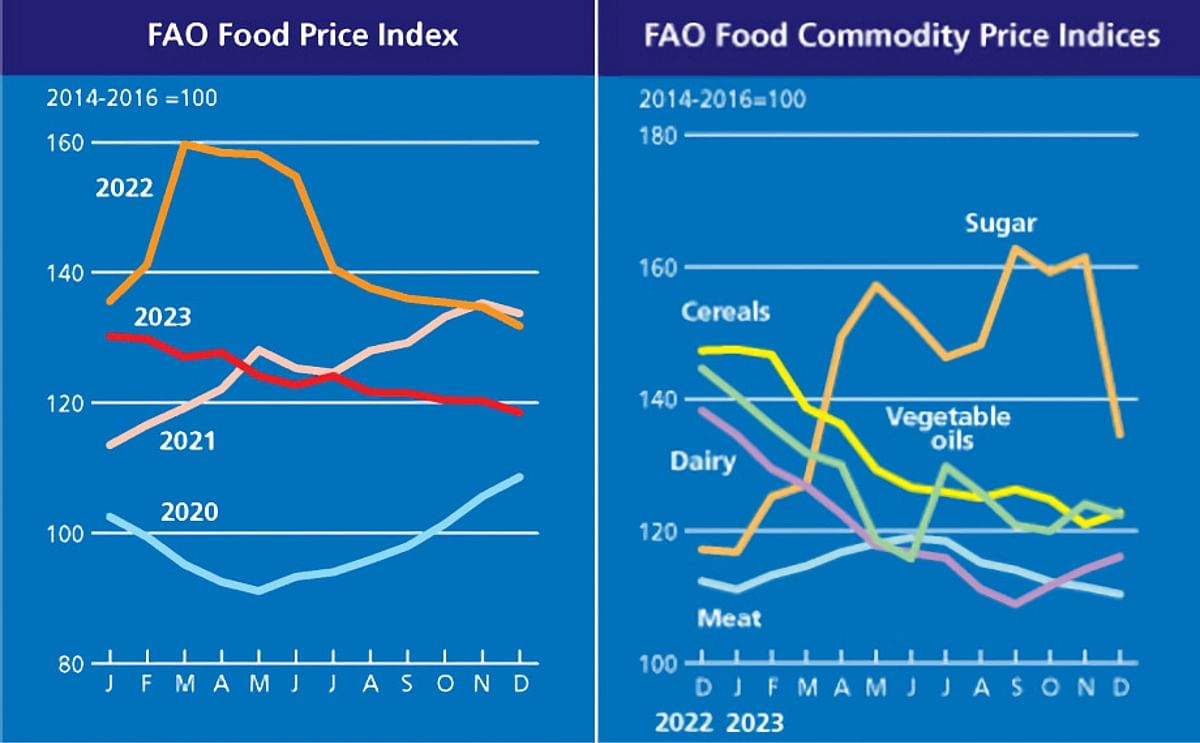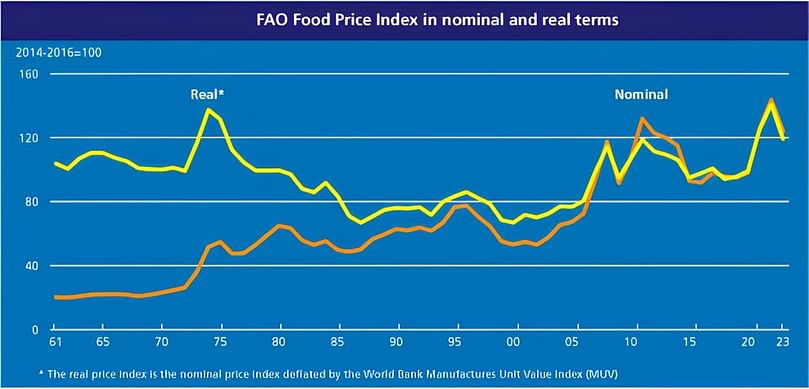FAO Food Price index eased substantially in 2023
FAO Food Price index eased substantially in 2023

The FAO Food Price Index* (FFPI) stood at 118.5 points in December 2023, down 1.8 points (1.5 percent) from its November level, as decreases in the price indices for sugar, vegetable oils and meat more than offset increases in dairy products and cereals. The index stood 13.3 points (10.1 percent) below its corresponding level one year ago. For 2023 as a whole, the index recorded 124.0 points, 19.7 points (13.7 percent) lower than the average value in 2022.
The FAO Cereal Price Index averaged 122.8 points in December, up 1.8 points (1.5 percent) from November, but still 24.4 points (16.6 percent) below its December 2022 value. After falling for four consecutive months, wheat export prices increased in December, supported by weather-related logistical disruptions in some major exporters and tensions in the Black Sea amidst solid demand.
World maize prices also strengthened in December, underpinned by concerns about Brazil’s second crop plantings, and logistical constraints hindering shipments from Ukraine. Among other coarse grains, world prices of barley increased, while sorghum prices decreased slightly.
In December, the FAO All Rice Price Index rose 1.6 percent above its November level. Indica quotations underpinned this increase, rising in response to purchases by some Asian buyers and reduced competition among exporters owing to India's export restrictions and tight availabilities in Viet Nam.
According to the rice index, international rice prices registered a 21 percent annual increase in 2023, largely owing to concerns about the impact of El Niño on rice production and in the aftermath of export restrictions imposed by India. For the year as a whole, the FAO Cereal Price Index stood at 130.9 points in 2023, down 23.8 points (15.4 percent) from the 2022 record annual average, reflecting well supplied global markets.
The FAO Vegetable Oil Price Index averaged 122.4 points in December, down 1.7 points (1.4 percent) month-on-month after a short-lived increase in November. The decline of the price index reflected lower world prices across palm, soy, rapeseed and sunflower seed oils, underpinned by subdued purchases from major importers, despite the seasonally lower outputs in leading producing countries.
Meanwhile, world soyoil prices dropped by more than 3 percent from November as a result of a slowdown in demand from the biodiesel sector, as well as improving weather conditions in parts of the main growing regions in Brazil.
International rapeseed and sunflower seed oils prices declined on tame global import demand. For 2023 as a whole, the FAO Vegetable Oil Price Index stood at 126.3 points, down sharply (by 61.5 points or 32.7 percent) from 2022 and marking a three-year low amid improved global supplies.
The FAO Dairy Price Index averaged 116.1 points in December, up 1.9 points (1.6 percent) from November, marking the third consecutive monthly increase and standing 22.2 points (16.1 percent) below its corresponding value one year ago. The December increase in the index was led by higher price quotations for butter, whole milk powder (WMP) and cheese.
As for butter and cheese, international prices rose, principally underpinned by strong internal sales in Western Europe ahead of the holiday season in contrast with a continued supply tightness in the market, despite the region’s milk deliveries rising seasonally. In addition, increased import demand from the Near East also supported cheese price quotations.
Meanwhile, strong global import demand led international WMP prices to rise, while markets in Europe remained largely inactive due to holidays. By contrast, world skim milk power prices fell slightly due to limited demand.
In 2023 as a whole, the FAO Dairy Price Index averaged 118.8 points, down 23.6 points (16.6 percent) below the average for 2022, underpinned by lackluster import demand, especially for spot supplies, amid ample stocks in importing countries, reflecting price declines across all dairy products.
The FAO Meat Price Index* averaged 110.4 points in December, down 1.1 points (1.0 percent) from November, standing 2.0 points (1.8 percent) below its corresponding value one year ago. In December, international pig meat prices fell, underpinned by the persistent weak import demand from Asia, despite an upturn in seasonal internal sales in some exporting countries.
Meanwhile, bovine and poultry meat prices also fell, reflecting less active buying interest in Asia, coupled with ample exportable supplies in large producing regions. By contrast, ovine meat prices rebounded following two months of consecutive drops due to stronger demand ahead of holidays and a decline in slaughter supplies in Oceania as recent rains eased pressure for offloading animals for slaughter.
In 2023 as a whole, the FAO Meat Price Index averaged 114.6 points, down 4.2 points (3.5 percent) from 2022, due to increased export availabilities from leading exporting regions amid subdued import demand by key meat-importing countries reflecting declines in annual average values for bovine, poultry and ovine meats, partially compensated by an increase in average pig meat prices.
The FAO Sugar Price Index averaged 134.6 points in December, down 26.8 points (16.6 percent) from November, marking the lowest level in the past nine months, but remaining 17.5 points (14.9 percent) above its level in the same month last year. The December plunge in international sugar price quotations was mainly driven by the strong pace of production in Brazil, bolstered by conducive weather conditions.
Strong exports from Brazil, along with lower returns from ethanol sales, contributed to the overall decline in world sugar prices. In addition, the decision of the Government of India to limit the use of sugarcane for ethanol production in the current season exerted some further downward pressure on prices. For 2023 as a whole, the FAO Sugar Price Index averaged 145 points, up 30.6 points (26.7 percent) from 2022 and the highest value since 2011 mainly on concerns over a tighter global sugar balance.

The FAO Cereal Price Index averaged 122.8 points in December, up 1.8 points (1.5 percent) from November, but still 24.4 points (16.6 percent) below its December 2022 value. After falling for four consecutive months, wheat export prices increased in December, supported by weather-related logistical disruptions in some major exporters and tensions in the Black Sea amidst solid demand.
World maize prices also strengthened in December, underpinned by concerns about Brazil’s second crop plantings, and logistical constraints hindering shipments from Ukraine. Among other coarse grains, world prices of barley increased, while sorghum prices decreased slightly.
In December, the FAO All Rice Price Index rose 1.6 percent above its November level. Indica quotations underpinned this increase, rising in response to purchases by some Asian buyers and reduced competition among exporters owing to India's export restrictions and tight availabilities in Viet Nam.
According to the rice index, international rice prices registered a 21 percent annual increase in 2023, largely owing to concerns about the impact of El Niño on rice production and in the aftermath of export restrictions imposed by India. For the year as a whole, the FAO Cereal Price Index stood at 130.9 points in 2023, down 23.8 points (15.4 percent) from the 2022 record annual average, reflecting well supplied global markets.
The FAO Vegetable Oil Price Index averaged 122.4 points in December, down 1.7 points (1.4 percent) month-on-month after a short-lived increase in November. The decline of the price index reflected lower world prices across palm, soy, rapeseed and sunflower seed oils, underpinned by subdued purchases from major importers, despite the seasonally lower outputs in leading producing countries.
Meanwhile, world soyoil prices dropped by more than 3 percent from November as a result of a slowdown in demand from the biodiesel sector, as well as improving weather conditions in parts of the main growing regions in Brazil.
International rapeseed and sunflower seed oils prices declined on tame global import demand. For 2023 as a whole, the FAO Vegetable Oil Price Index stood at 126.3 points, down sharply (by 61.5 points or 32.7 percent) from 2022 and marking a three-year low amid improved global supplies.
The FAO Dairy Price Index averaged 116.1 points in December, up 1.9 points (1.6 percent) from November, marking the third consecutive monthly increase and standing 22.2 points (16.1 percent) below its corresponding value one year ago. The December increase in the index was led by higher price quotations for butter, whole milk powder (WMP) and cheese.
As for butter and cheese, international prices rose, principally underpinned by strong internal sales in Western Europe ahead of the holiday season in contrast with a continued supply tightness in the market, despite the region’s milk deliveries rising seasonally. In addition, increased import demand from the Near East also supported cheese price quotations.
Meanwhile, strong global import demand led international WMP prices to rise, while markets in Europe remained largely inactive due to holidays. By contrast, world skim milk power prices fell slightly due to limited demand.
In 2023 as a whole, the FAO Dairy Price Index averaged 118.8 points, down 23.6 points (16.6 percent) below the average for 2022, underpinned by lackluster import demand, especially for spot supplies, amid ample stocks in importing countries, reflecting price declines across all dairy products.
The FAO Meat Price Index* averaged 110.4 points in December, down 1.1 points (1.0 percent) from November, standing 2.0 points (1.8 percent) below its corresponding value one year ago. In December, international pig meat prices fell, underpinned by the persistent weak import demand from Asia, despite an upturn in seasonal internal sales in some exporting countries.
Meanwhile, bovine and poultry meat prices also fell, reflecting less active buying interest in Asia, coupled with ample exportable supplies in large producing regions. By contrast, ovine meat prices rebounded following two months of consecutive drops due to stronger demand ahead of holidays and a decline in slaughter supplies in Oceania as recent rains eased pressure for offloading animals for slaughter.
In 2023 as a whole, the FAO Meat Price Index averaged 114.6 points, down 4.2 points (3.5 percent) from 2022, due to increased export availabilities from leading exporting regions amid subdued import demand by key meat-importing countries reflecting declines in annual average values for bovine, poultry and ovine meats, partially compensated by an increase in average pig meat prices.
The FAO Sugar Price Index averaged 134.6 points in December, down 26.8 points (16.6 percent) from November, marking the lowest level in the past nine months, but remaining 17.5 points (14.9 percent) above its level in the same month last year. The December plunge in international sugar price quotations was mainly driven by the strong pace of production in Brazil, bolstered by conducive weather conditions.
Strong exports from Brazil, along with lower returns from ethanol sales, contributed to the overall decline in world sugar prices. In addition, the decision of the Government of India to limit the use of sugarcane for ethanol production in the current season exerted some further downward pressure on prices. For 2023 as a whole, the FAO Sugar Price Index averaged 145 points, up 30.6 points (26.7 percent) from 2022 and the highest value since 2011 mainly on concerns over a tighter global sugar balance.
Unlike for other commodity groups, most prices utilized in the calculation of the FAO Meat Price Index are not available when the FAO Food Price Index is computed and published; therefore, the value of the Meat Price Index for the most recent months is derived from a mixture of projected and observed prices. This can, at times, require significant revisions in the final value of the FAO Meat Price Index which could in turn influence the value of the FAO Food Price Index.

FAO Food Price Index in nominal and real terms
Like to receive news like this by email? Join and Subscribe!
Get the latest potato industry news straight to your WhatsApp. Join the PotatoPro WhatsApp Community!
Uitgelichte Bedrijven
Sponsored Content
Sponsored Content
Sponsored Content
Sponsored Content










